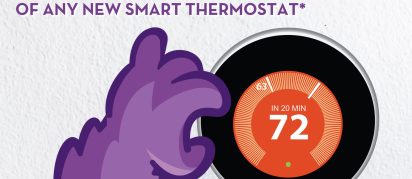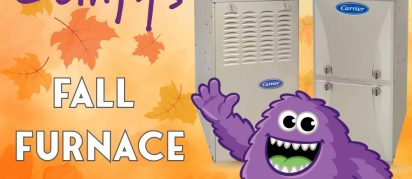How to Test Your Heating System

When the first really cold days hit North Carolina, everyone who hasn’t turned on their system since last spring does the same thing at the same time — And for the systems that don’t work, that’s when everyone calls Comfort Monster (or another HVAC company).
In order to avoid the rush, we recommend testing the functionality of your system before you really need it. Here’s how:
What you need:
We recommend having some sort of thermometer. A digital meat thermometer works great, but anything that will fairly accurately read temperatures from 70°F to 120°F should be ok. (Also, you need to have a heating system. Obviously.)
First, Determine Your Heat Source:
First you need to determine whether you have a heat pump or furnace (for all other types of heat just call us for an inspection or tune-up). If you already know what kind of heating you have, jump to the steps below specifically for each heat source. If you don’t have any gas appliances or pay a gas bill at your home, you probably have a heat pump. If you don’t know how your home is heated, there really isn’t a particularly easy way for you to verify it other than looking at model numbers and/or crawling around under your house. Call us and we’ll give you a full heating tune-up and let you know what kind of system you have for future reference.
Heat Pump
- First, check your filters. Clean filters are the first step to the proper function and long-life of any HVAC system. If your filters are clogged or dirty, you can remove them temporarily for this test, but get new ones asap. You should read our article about HVAC filter recommendations if an HVAC professional hasn’t already recommended specific filters for your home.
- Set your thermostat to ‘heat’ mode. We don’t really recommend ‘Auto’ mode but if it’s already in ‘Auto’ you can skip this step.
- Bump the temperature up 3-4 degrees above the room temperature so the heat will come on.
- Watch the thermostat for a minute or two and make sure “aux” or “emergency” heat doesn’t come on yet.
- Check outside and make sure the condenser unit started up successfully and you don’t hear any unusual noises.
- Check 1-2 registers on each floor this unit provides heating and cooling for. On a heat pump operating properly (and not in aux or emergency mode), with the outdoor temperature between 45°F and 60°F, you should get a thermometer reading of at least 25 degrees higher than your indoor air temperature. We call that the delta-T or change in temperature.
- If the outside temperature is above 35°F-40°F, this step shouldn’t work due to an energy saving “lockout”. However it’s worth testing. If your thermostat has a setting for emergency heat, turn it on. You might also have to bump the temperature up 5+ degrees to make it turn on. Wait a few minutes and check the temperature again. You should see a temperature rise of at least 25-30 degrees above the ambient house temperature inside.
- Listen carefully for any noise or vibrations
- A slight and temporary “dusty” burning smell is ok, but it should not smell like electrical burning or anything with a chemical smell.
- If you are not 100% sure your heat pump is operating properly, give us a call for a fall tune-up.
Gas Furnace
- First, check your filters. Clean filters are the first step to the proper function and long-life of any HVAC system. If your filters are clogged or dirty, you can remove them temporarily for this test, but get new ones asap. You should read our article about HVAC filter recommendations if an HVAC professional hasn’t already recommended specific filters for your home.
- Second, make sure you have carbon monoxide detectors. These detectors are critical when you have any gas appliance in your home.
- Set your thermostat to ‘heat’ mode. We don’t really recommend ‘Auto’ mode, but if it’s already in ‘Auto’ you can skip this step.
- Bump the temperature up 3-4 degrees above the room temperature so the heat will come on.
- Wait about 2 minutes and then check 1-2 registers on each floor this unit provides heating and cooling for. Specific furnaces may vary, but a thermometer reading between 45°F-80°F degrees higher than your indoor air temperature. 60°F-70°F degrees is usually a good number. You don’t want to be too close to the upper or lower limits.
- Listen carefully for any noise or vibrations
- Let the furnace operate for about 10 minutes and make sure it continues to function properly.
- A slight and temporary “dusty” burning smell is ok, but it should not smell like electrical burning or anything with a chemical smell.
- If you are not 100% sure your heat pump is operating properly, give us a call for a fall tune-up.



